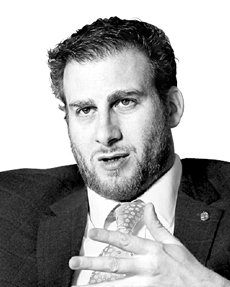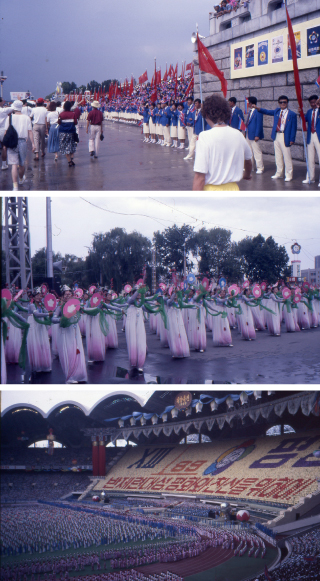The 1989 wind of change and its effect on the North

The author is the Hungarian ambassador to Korea.
The Berlin Wall, the dark symbol of the Cold War period, fell 30 years ago. Listening to the famous rock ballad “Wind of Change” from the German band Scorpions is the best way to recall the atmosphere of 1989, when several unexpected developments unfolded in Central and Eastern Europe. It is also quite interesting to see how these changes influenced the northern part of the Korean Peninsula.
On Feb. 1, 1989, Hungary became the first socialist country to establish official diplomatic relations with South Korea. The North Korean Ministry of Foreign Affairs decided to downgrade the Budapest-Pyongyang relations from ambassadorial to chargé d’affaires and ordered the Hungarian ambassador, Mr. Mihaly Kornidesz, the former president of Hungarian Television, to leave the country as soon as possible. At the same time, North Korea forwarded a threatening statement to Hungary, issued by the so-called Hanminjon, a phantom organization made up by the North Korean leadership. The non-existent organization declared that Hungary “has become an enemy of the Koreans and socialism.” They warned the “traitors” that they would take measures and “remove the Hungarian tricolor.”
Reassurance from the K.G.B.
The statement directly threatened the Hungarian Embassy in Seoul; therefore, a special South Korean military unit guarded the Hungarian mission from February 1989. According to the documents from the Historical Archives of the Hungarian State Security, due to the seriousness of the threat, the Ministry of Internal Affairs in Budapest asked for the opinion of the Soviet partner organization in March 1989. From the Soviet Embassy to Budapest, a K.G.B. officer responded to the request and wrote that the North Koreans usually threatened others as a part of their political pressure. The K.G.B. agent added that, because of the advanced level of the South Korean security services, there is only a “slight possibility” for any steps to be taken against the Hungarian mission. The Soviet officer also wrote that the North Koreans would not do anything because they knew well that a possible action against Hungary could hurt their relations with the other socialist countries. In other words, the leadership in Pyongyang was concerned about the reaction of Soviet leader Mikhail Gorbachev, who was much closer to Hungary and the reformist countries at that time.
It is more than symbolic to compare the developments which took place in the falling Soviet Empire during the summer of 1989. In Eastern Germany, tens of thousands of people decided to defect from the country, Hungary being the destination for most of them, because the reformist country started to remove its barriers on the Austrian border. In Budapest, the political leadership accepted the request of the opposition forces to hold a commemorative funeral for the late Hungarian Prime Minister Imre Nagy, the leading figure of the Hungarian anti-Stalinist revolution in 1956, who was executed two years later. The funeral, which took place in June 1989, became a nationwide demonstration against the crimes of communism. It is interesting to mention that most of the diplomatic corps were present at the event, except the diplomatic missions from Albania, China, Romania and North Korea.

From top: In 1989, North Korea organized its largest-ever event for foreigners in Pyongyang; Welcoming parade for the foreign guests of the Pyongyang Festival; The opening ceremony was organized in the style of the Olympic Games.[FROM THE COLLECTION OF ERZSEBET BOTH]
Meanwhile, to compensate for the for the great success of the Seoul Oympics the previous year, the North Korean leadership hosted the World Festival of Youth and Students (WFYS) in Pyongyang in July 1989. The WFYS was one of the most popular youth events in the Soviet bloc countries from the late 1940s and usually was held biannually. However, in 1989, the festival was organized in the shadow of falling communism in Eastern Europe and the Tiananmen Square incident in Beijing. The festival’s opening ceremony was held in the Rungrado 1st of May Stadium in Pyongyang, and it was organized in the style of the Olympic Games. Some pro-Pyongyang leaders from the third world — for instance, President Robert Mugabe from Zimbabwe, Julius Nyerere from Tanzania, Prince Norodom Sihanouk from Cambodia — participated in the event. During the opening speech of President Kim Il Sung, a Danish group raised a banner asking for human rights for the North Korean people, but the group was forcefully removed. Lars L. Rasmussen, the head of the Danish group, said the following to a Hungarian correspondent: “When Kim Il Sung said in his opening speech that the new generation would have to live without oppression all around the world, we tried to raise a banner with the following sentence: Human rights in North Korea too! But we couldn’t raise the banner because [North] Korean security guards, who were wearing grey civilian clothes, grabbed us from behind. They wanted to snatch the banner away and punched my back. I wanted to stay in my seat, but they picked up my chair while I was still sitting in it. Maybe they wanted to warn me that during the speech of the great leader everybody should stand up.” As well as the Danish, the Finnish and Norwegian participants had also made it clear in advance that they would like to talk about human rights in North Korea at the festival. Hence, the organizers were concerned that the Kim Il Sung Square in Pyongyang could possibly become the venue of an international student protest.
The 155 members of the Hungarian delegation made various observations in Pyongyang. The correspondent for the Hungarian weekly Ma-gyarorszag pointed out the huge contrast between the new Japanese-made air-conditioned buses and the strictly controlled atmosphere. North Korean security guards wearing grey civilian clothes could be seen everywhere. Their armpit pistol holsters were visible through their jackets. The correspondent also mentioned that the security guards were equipped with electronic beepers for communication. In one of his other articles, the journalist wrote about his strange conversations with a local guide, who introduced herself as a university student majoring in English but who had never heard of Shakespeare or Hemingway. The Hungarian correspondent also wrote in one of his articles that the North Koreans could not keep the gifts that they had received from foreigners. The Hungarian delegation gave out colorful brochures about Hungary and Rubik’s Cubes with the logo of the festival to local and foreign participants, but the security guards took them away from the locals. However, the interaction with foreigners had a deep impact on the North Koreans. For example, during the festival, the neighborhood around Kwangbok Street in Pyongyang was filled with the sounds of hits from Madonna and Michael Jackson. The festival gave thousands of North Koreans an opportunity to catch a glimpse of contemporary Western culture. According to the memories of some North Korean refugees, after the festival, disco music and the so-called nallari chum (hooligan dance) became very popular among the younger generation.
Withdraw North Korean students
During the tsunami of political changes in Central and Eastern Europe, some North Korean students, who were studying there, decided to avoid their expected repatriation back to Pyongyang.
In the first half of 1989, two North Korean dental students, Cho Seung-gun and Kim Un-chul, escaped from Czechoslovakia. Later, Cho said during a press conference in Seoul that he recognized a new way of life living abroad and that he did not want to live in North Korea anymore. Kim recalled that he had decided to escape after watching the broadcast of the Seoul Olympics because he realized that everything he had learned about South Korea was false.
At that time, around 150 North Korean students were studying in Czechoslovakia. Weeks later, two other North Korean students arrived to Seoul, but this time from Poland. Tong Yong-jun studied at the University of Gdansk, and Kim Un-hak studied at the Technical College of Warsaw. The students decided to escape when they heard that the other two had left Czechoslovakia successfully. Kim Un-hak expressed his wish in Seoul that many of the 120 students studying in Poland would follow their example.
At that time, a total of 122 North Korean students were studying at various universities and colleges in Hungary. In July, 1989, the North Korean chargé d’affaires visited the Ministry of Foreign Affairs in Budapest and announced that they had collected the North Korean students five days earlier and sent them back to Pyongyang on a special plane. However, the diplomat stated that the students would come back to Hungary after the one-and-a-half-month summer vacation. Nevertheless, in the first days of September, the North Korean envoy visited the Ministry of Culture and Education, where he finally announced that the North Korean students were not coming back.
After the fall of the Berlin Wall, two North Korean students escaped from East Germany. Geology student Chang Yong-chul and information technology student Chun Chul-u took the prime opportunity to seek asylum at the South Korean Consulate in West Berlin. It is interesting to mention that Chun Chul-u later became a famous entertainer is Seoul, where he also established a popular naengmyeon restaurant (Pyongyang-style noodle soup) chain.
Few know that the developments in Central and Eastern Europe triggered a limited student movement in North Korea from the autumn of 1989. A small number of university students in Pyongyang made posters criticizing the rule of President Kim Il Sung and Kim Jong-il. According to refugees from North Korea, the authorities arrested all of the participants, and most of them were sentenced to death.
Kim Il Sung on the developments
In the autumn of 1989, the world system of the Cold War period changed. In late October 1989, the Czechoslovakian ambassador to Pyongyang visited President Kim Il Sung, and the subject of the Central and Eastern European changes came up. According to archive diplomatic sources, Kim said that they were observing the developments and appreciated the corrections of the past failures, but — since there were no failures in North Korea — they had nothing to correct. Kim appreciated the consequent policy of Czechoslovakia but warned them of the Hungarian and Polish developments. According to Kim, the communists in Poland had resigned from power willingly, and the Hungarian communists had liquidated their own party with their own hands.
Nowadays, the official point of view on history in North Korea states that the person responsible for the Central and Eastern European political changes was the Soviet leader Mikhail Gorbachev. “Segye Ryoksa,” the world history textbook for middle school students states that the Soviet reform policy resulted in the change of leadership in the socialist countries but the new leaders were the “enemies of socialism.”
According to the North Korean textbook, the return of capitalism is a “temporary phenomenon” because proceeding to socialism is the “law of history.” However, the citizens of the Central and Eastern European countries, who directly experienced the hardships and crimes of the ancient regimes, know well that 1989 was glorious, as it is well expressed in the Scorpions’ ballad.










with the Korea JoongAng Daily
To write comments, please log in to one of the accounts.
Standards Board Policy (0/250자)